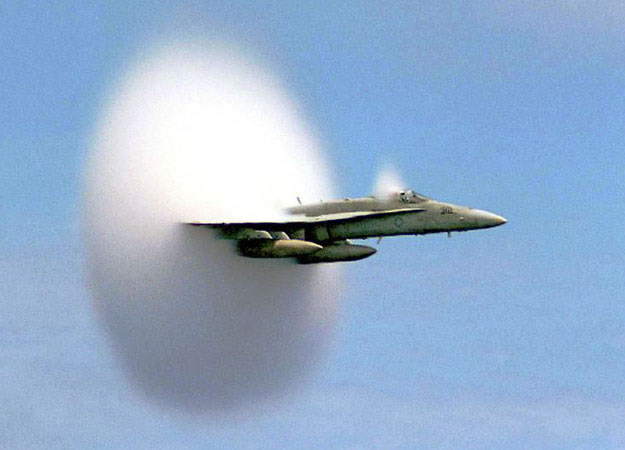A sonic boom is the thunder-like noise a person
on the ground hears
when an aircraft or other type
of aerospace vehicle flies
overhead faster
than the speed of sound or supersonic.
Air reacts like a fluid to supersonic objects. As objects travel through the air, the air molecules are pushed aside with great force and this forms a shock wave much like a boat creates a bow wave. The bigger and heavier the aircraft, the more air it displaces.
The Cause
The shock wave forms a cone of pressurized air molecules which move outward and rearward in all directions and extend to the ground. As the cone spreads across the landscape along the flight path, they create a continuous sonic boom along the full width of the cone's base. The sharp release of pressure, after the buildup by the shock wave, is heard as the sonic boom.
The change in air pressure associated with a sonic boom is only a few pounds per square foot -- about the same pressure change experienced riding an elevator down two or three floors. It is the rate of change, the sudden onset of the pressure change, that makes the sonic boom audible.
All aircraft generate two cones, at the nose and at the tail. They are usually of similar strength and the time interval between the two as they reach the ground is primarily dependent on the size of the aircraft and its altitude. Most people on the ground cannot distinguish between the two and they are usually heard as a single sonic boom. Sonic booms created by vehicles the size and mass of the space shuttle are very distinguishable and two distinct booms are easily heard.
General Factors Associated With Sonic Booms
There are several factors that can influence sonic booms -- weight, size, and shape of the aircraft or vehicle, plus its altitude, attitude and flight path, and weather or atmospheric conditions.
A larger and heavier aircraft must displace more air and create more lift to sustain flight, compared with small, light aircraft. Therefore, they will create sonic booms stronger and louder than those of smaller, lighter aircraft. The larger and heavier the aircraft, the stronger the shock waves will be.
Altitude determines the distance shock waves travel before reaching the ground, and this has the most significant effect on intensity. As the shock cone gets wider, and it moves outward and downward, its strength is reduced. Generally, the higher the aircraft, the greater the distance the shock wave must travel, reducing the intensity of the sonic boom. Of all the factors influencing sonic booms, increasing altitude is the most effective method of reducing sonic boom intensity.
The width of the boom "carpet" beneath the aircraft is about one mile for each 1000 feet of altitude. An aircraft, for example, flying supersonic at 50,000 feet can produce a sonic boom cone about 50 miles wide. The sonic boom, however, will not be uniform. Maximum intensity is directly beneath the aircraft, and decreases as the lateral distance from the flight path increases until it ceases to exist because the shock waves refract away from the ground. The lateral spreading of the sonic boom depends only upon altitude, speed and the atmosphere -- and is independent of the vehicle's shape, size, and weight.
The ratio of aircraft length to maximum cross sectional area also influences the intensity of the sonic boom. The longer and more slender the aircraft, the weaker the shock waves. The fatter and more blunt the vehicle, the stronger the shock wave can be.
Increasing speeds above Mach 1.3 results in only small changes in shock wave strength.
The direction of travel and strength of shock waves are influenced by wind, speed, and direction, and by air temperature and pressure. At speeds slightly greater than Mach 1, their effect can be significant, but their influence is small at speeds greater than Mach 1.3. Distortions in the shape of the sonic boom signatures can also be influenced by local air turbulence near the ground. This, too, will cause variations in the overpressure levels.
Aircraft maneuvering can cause distortions in shock wave patterns. Some maneuvers -- pushovers, acceleration and "S" turns -- can amplify the intensity of the shock wave. Hills, valleys and other terrain features can create multiple reflections of the shock waves and affect intensity.
Overpressure
Sonic booms are measured in pounds per square foot of overpressure. This is the amount of the increase over the normal atmospheric pressure which surrounds us (2,116 psf/14.7 psi).
At one pound overpressure, no damage to structures would be expected.
Overpressures of 1 to 2 pounds are produced by supersonic aircraft flying at normal operating altitudes. Some public reaction could be expected between 1.5 and 2 pounds.
Rare minor damage may occur with 2 to 5 pounds overpressure.
As overpressure increases, the likelihood of structural damage and stronger public reaction also increases. Tests, however, have shown that structures in good condition have been undamaged by overpressures of up to 11 pounds.
Sonic booms produced by aircraft flying supersonic at altitudes of less than 100 feet, creating between 20 and 144 pounds overpressure, have been experienced by humans without injury.
Damage to eardrums can be expected when overpressures reach 720 pounds. Overpressures of 2160 pounds would have to be generated to produce lung damage.
Typical overpressure of aircraft types are:
|





